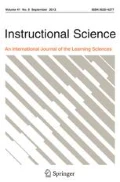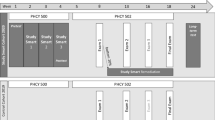Abstract
This study examined the effects of type of assessment criteria (performance-based vs. competency-based), the relevance of assessment criteria (relevant criteria vs. all criteria), and their interaction on secondary vocational education students’ performance and assessment skills. Students on three programmes in the domain of nursing and care (N = 93) participated in the study. Results show that students who were given the relevant criteria made more accurate assessments of an expert model, performed better on a test and achieved higher instructional efficiency (defined as the relationship between performance and mental effort) compared to students who were given all criteria. Students who were given performance-based assessment criteria made more accurate assessments of an expert model and scored higher on task performance during practice compared to students who were given competency-based assessment criteria. They invested less mental effort in the assessments, resulting in higher instructional efficiency. An interaction effect for the concreteness of answers shows that the combination of performance-based and relevant criteria leads to superior analysis of worked examples compared to the other combinations of criteria.






Similar content being viewed by others
References
Albanese, M. A., Mejicano, G., Anderson, W. M., & Gruppen, L. (2010). Building a competency-based curriculum: The agony and the ecstasy. Advances in Health Sciences Education, 15(3), 439–454.
Alinier, G., Hunt, B., Gordon, R., & Harwood, C. (2006). Effectiveness of intermediate-fidelity simulation training technology in nursing education. Journal of Advanced Nursing, 54(3), 359–369.
Biemans, H., Nieuwenhuis, L., Poell, R., Mulder, M., & Wesselink, R. (2004). Competence-based VET in the Netherlands: Background and pitfalls. Journal of Vocational Education and Training, 54(4), 523–538.
Biemans, H., Wesselink, R., Gulikers, J., Schaafsma, S., Verstegen, J., & Mulder, M. (2009). Towards competence-based VET: Dealing with the pitfalls. Journal of Vocational Education & Training, 61(3), 267–286.
Birenbaum, M. (2003). New insights into learning and teaching and their implications for assessment. In M. Segers, F. Dochy, & E. Cascallar (Eds.), Optimising new modes of assessment: In search of qualities and standards (pp. 13–36). Dordrecht, the Netherlands: Kluwer Academic Publishers.
Brockmann, M., Clarke, L., Méhaut, P., & Winch, C. (2008). Competence-based vocational education and training (VET): The cases of England and France in a European perspective. Vocations and Learning, 1, 227–244.
COLO. (2008). Prepared for the future: Dutch qualifications for the labour market. Retrieved from http://www.colo.nl/publications.html.
Corbalan, G., Kester, L., & van Merriënboer, J. J. G. (2009). Dynamic task selection: Effects of feedback and learner control on efficiency and motivation. Learning and Instruction, 19, 455–465.
Crossley, J., & Jolly, B. (2012). Making sense of work-based assessment: Ask the right questions, in the right way, about the right things, of the right people. Medical Education, 46(1), 28–37.
Dearnley, C. A., & Meddings, F. S. (2007). Student self-assessment and its impact on learning. A pilot study. Nurse Education Today, 27, 330–340.
Deci, E. L., Eghrari, H., Patrick, B. C., & Leone, D. (1994). Facilitating internalization: The self-determination theory perspective. Journal of Personality, 62, 119–142.
Duchastel, P. C., & Merrill, P. F. (1973). The effects of behavioural objectives on learning: A review of empirical studies. Review of Educational Research, 43, 53–69.
Dunning, D., Heath, C., & Suls, J. M. (2004). Flawed self-assessment: Implications for health, education, and the workplace. Psychological Science in the Public Interest, 5(3), 69–106.
Ecclestone, K. (2001). ‘I know a 2:1 when I see it’: Understanding criteria for degree classifications in franchised university programmes. Journal of Further and Higher Education, 25(3), 301–313.
Fastré, G. M., van der Klink, M., & van Merriënboer, J. J. G. (2010). The effects of performance-based assessment criteria on student performance and self-assessment skills. Advances in Health Sciences Education, 15(4), 517–532.
Fastré, G. M., van der Klink, M., van Merriënboer, J. J. G., & Sluijsmans, D. (2012). Drawing students’ attention to relevant assessment criteria: Effects on self-assessment skills and performance. Journal of vocational education and training, 64(2), 185–198.
Garside, J., Nhemachena, J. Z. Z., Williams, J., & Topping, A. (2009). Repositioning assessment: Giving students the ‘choice’ of assessment methods. Nurse Education in Practice, 9, 141–148.
Grégoire, J. (1997). Diagnostic assessment of learning disabilities: From assessment of performance to assessment of competence. European Journal of Psychological Assessment, 13(1), 10–20.
Gulikers, J. T. M., Baartman, L. K. J., & Biemans, H. J. A. (2010). Facilitating evaluations of innovative, competence-based assessments: Creating understanding and involving multiple stakeholders. Evaluation and Program Planning, 33, 120–127.
Gulikers, J. T. M., Kester, L., Kirschner, P. A., & Bastiaens, Th J. (2008). The influence of practical experience on perceptions, study approach and learning outcomes in authentic assessment. Learning and Instruction, 18(2), 172–186.
Hoyt, W. T., & Kerns, M. D. (1999). Magnitude and moderators of bias in observer ratings: A meta analysis. Psychological Methods, 4, 403–424.
Kicken, W., Brand-Gruwel, S., & van Merriënboer, J. J. G. (2006). Self-directed learning skills questionnaire. Heerlen, the Netherlands: Open Universiteit Nederland.
Kicken, W., Brand-Gruwel, S., & van Merriënboer, J. J. G. (2008). Scaffolding advice on task selection: A safe path toward self-directed learning in on-demand education. Journal of Vocational Education and Training, 60, 223–239.
Koh, L. C. (2008). Refocusing formative feedback to enhance learning in pre-registration nurse education. Nurse Education in Practice, 8, 223–230.
Leung, S. F., Mok, E., & Wong, D. (2008). The impact of assessment methods on the learning of nursing students. Nurse Education Today, 28, 711–719.
Lurie, S. J. (2012). History and practice of competency-based assessment. Medical Education, 46, 49–57.
Mager, R. (1975). Preparing instructional objectives (2nd ed.). Belmont, CA: Lake Publishing Co.
Malone, K., & Supri, S. (2012). A critical time for medical education; the perils of competence-based reform of the curriculum. Advances in Health Science Education, 17, 241–246.
Martens, R. L. & Kirschner, P. A. (2004). What predicts intrinsic motivation? Paper presented at the 2004 AECT convention, Chicago.
Miller, G. E. (1990). The assessment of clinical skills/competence/performance. Academic Medicine, 65, S63–S67.
Norcini, J., Anderson, B., Bollela, V., Burch, V., Costa, M. J., Duvivier, R., et al. (2011). Criteria for good assessment: Consensus statement and recommendations from the Ottawa 2010 Conference. Medical Teacher, 33(3), 206–214.
Nunnally, J. C., & Bernstein, I. H. (1994). Psychometric theory. New York, NY: McGraw-Hill.
Paas, F., Tuovinen, J. E., Tabbers, H., & van Gerven, P. (2003). Cognitive load measurement as a means to advance cognitive load theory. Educational Psychologist, 38(1), 63–71.
Paas, F., & van Merriënboer, J. J. G. (1993). The efficiency of instructional conditions: An approach to combine mental effort and performance measures. Human Factors, 35, 737–743.
Regehr, G., & Eva, K. (2006). Self-assessment, self-direction, and the self-regulating professional. Clinical Orthopaedics and Related Research, 449, 34–38.
Sadler, D. R. (1985). The origins and functions of evaluative criteria. Educational Theory, 35(3), 285–297.
Sadler, D. R. (1989). Formative assessment and the design of instructional systems. Instructional Science, 18, 119–144.
Stark, R., Kopp, V., & Fischer, M. R. (2009). Case-based learning with worked examples in complex domains: Two experimental studies in undergraduate medical education. Learning and Instruction. doi:10.1016/j.learninstruc.2009.10.001.
Sweller, J., van Merriënboer, J. J. G., & Paas, F. (1998). Cognitive architecture and instructional design. Educational Psychology Review, 10, 251–294.
van der Klink, M. R., Boon, J., & Schlusmans, K. (2007). Competences and vocational higher education: Now and in future. European Journal of Vocational Training, 30(1), 67–82.
Van Gog, T., & Paas, F. (2008). Instructional efficiency: Revisiting the original construct in educational research. Educational Psychologist, 43, 16–26.
Van Merriënboer, J. J. G., & Kirschner, P. A. (2007). Ten steps to complex learning. Mahwah, NJ: Erlbaum/Taylor and Francis.
Van Merriënboer, J. J. G., & Sweller, J. (2005). Cognitive load theory and complex learning: Recent developments and future directions. Educational Psychology Review, 17, 147–177.
Wierstra, R. F. A., Kanselaar, G., van der Linden, J. L., & Lodewijks, H. G. L. C. (1999). Learning environment perceptions of European university students. Learning Environments Research, 2, 79–98.
Author information
Authors and Affiliations
Corresponding author
Rights and permissions
About this article
Cite this article
Fastré, G.M.J., van der Klink, M.R., Amsing-Smit, P. et al. Assessment criteria for competency-based education: a study in nursing education. Instr Sci 42, 971–994 (2014). https://doi.org/10.1007/s11251-014-9326-5
Received:
Accepted:
Published:
Issue Date:
DOI: https://doi.org/10.1007/s11251-014-9326-5




